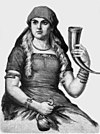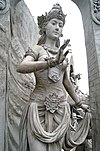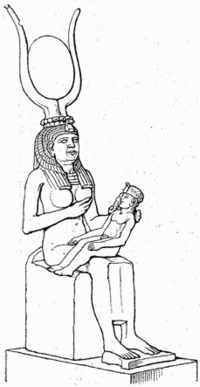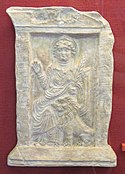Bogini Matka
Bogini Matka, Wielka Bogini, Wielka Macierz, Matka Ziemia, Królowa Niebios, Magna Mater – w wierzeniach wielu kultur główne (lub jedno z główniejszych) bóstwo w panteonie. Bogini utożsamiana najczęściej z Ziemią (lub stanowiąca jej patronkę), w wielu kulturach będąca równocześnie królową niebios (wówczas do jej atrybutów dochodziła jeszcze uroda). Zazwyczaj dawczyni wszelkiego życia, uosabiająca płodność (zob. kult płodności) i macierzyństwo. Często uznawana również za matkę bogów.
Psychologia
Powtarzający się w mitach motyw Bogini Matki według Carla Gustava Junga związany jest z archetypem matki – strukturą ukształtowaną w ludzkiej psychice ze względu na szczególne cechy matki. Do typowych form objawiania się tego archetypu Jung zalicza: własna matka, przybrana matka, zwłaszcza Matka Boża, w dalszym sensie Kościół, teściowa, mamka, motyw wielkiej matki pochodzący z historii religioznawstwa, kobieta przeczuwająca, biała dama; miasto, kraj, niebo, Ziemia, morze, w przenośnym sensie bogini, materia, Księżyc[1].
Bogini Matka w różnych religiach
Za Boginię Matkę uznawano:
| Wizerunek | Imię | Mitologia lub religia |
|---|---|---|
 | Al-Lat | mitologia arabska |
 | Astarte | mitologia fenicka |
 | Cihuacoatl | mitologia aztecka |
| Citlalincue | mitologia aztecka | |
| Danu | mitologia celtycka | |
 | Demeter | mitologia grecka |
 | Gaja | mitologia grecka |
 | Hebat | mitologia hetycka |
 | Isztar | mitologia sumeryjska |
 | Izyda | mitologia egipska |
| Ki | mitologia sumeryjska | |
 | Kybele | mitologia frygijska |
 | Maja | mitologia italska i rzymska |
 | Mokosz | mitologia słowiańska |
 | Ninhursag | mitologia sumeryjska |
 | Pachamama | mitologia inkaska |
 | Saule | mitologia bałtyjska |
 | Sif | mitologia nordycka |
| Tiamat | mitologia sumeryjska | |
 | Tellus | mitologia rzymska |
 | Prythiwi | mitologia indyjska |
Zobacz też
Przypisy
- ↑ Carl Gustav Jung: Grundwerk. T. 2: Die psychologischen Aspekte des Mutterarchetypus. Olten: Olten und Freiburg/Br., 1984, s. 148-149.
Media użyte na tej stronie
Autor: unknown, Licencja: CC0
Relief. Old Babylonian (Mesopotamia). Iraq, south. 19thC BC-18thC BC. Rectangular, baked clay relief panel, H 49.50 cm., Thickness: 4.8 cm.; modelled in relief on the front depicting a nude female figure with tapering feathered wings and talons, standing with her legs together; shown full frontal, wearing a headdress consisting of four pairs of horns topped by a disc; wearing an elaborate necklace and bracelets on each wrist; holding her hands to the level of her shoulders with a rod and ring in each; figure supported by a pair of addorsed lions above a scale-pattern representing mountains or hilly ground, and flanked by a pair of standing owls. Known as the "Burney Relief" or the "Queen of the Night". Museum number 2003,0718.1 [1]
Autor: Miguel Hermoso Cuesta, Licencja: CC BY-SA 3.0
The identity of the goddess on the Ara Pacis is unclear, possibly Italia, Tellus (Earth), Venus Genetrix (ancestres of the gens Julia) or Pax (Peace).[1]
Demeter. Marble, Roman copy after a Greek original from the 4th century BCE.
Autor: Marshall Astor, Licencja: CC BY-SA 2.0
Cybele with her traditional attributes (cornucopia, lion and crown in the shape of city walls). The face is an individualized portrait of Roman woman, probably of a high status. Roman marble, ca. 50 AD.
Autor: unknown, Licencja: CC BY-SA 3.0
Goddess Allât with palm tree and lion. Relief from the Ba'alshamîn temple. Supplement in Palmyrene script and language.
Attic red-figure calyx-krater, 410-400 B.C. Gaia. Detail from Gigantomachy.
Bull-man protecting a palmtree, female(?) deity (partially destroyed, reconstructed), panel of molded bricks. Terracotta, middle 12th century BC. Found at the Tell of the Apadana in Susa. The inscription running along the central band record that Shilhak-Inshushinak made a statue of brick for the exterior chapel of Inshushinak.
(c) Ben Pirard at nl.wikipedia, CC-BY-SA-3.0
A creature often incorrectly described as depicting Tiamat (see that article for why this is not an iamge of that mythological figure) on a Babylonian cylinder seal - uploaded without reference to any reliable source
Autor: Gunawan Kartapranata, Licencja: CC BY-SA 3.0
The statue of a woman in regal ancient Java attire in Monas (National Monument), Jakarta. The statue probably depicting Suhita, the Queen of Majapahit kingdom, or probably Ibu Pertiwi, the National Personification of Indonesia.
Autor: Mido mokomido, Licencja: CC BY-SA 3.0
Modern wooden statue of the goddess Mokosh
Autor: Penarc, Licencja: CC-BY-SA-3.0
Marta Colvin Pachamama (aymara Mother Earth), Sculptures Park, Providencia Ave., Santiago Chile
Early 20th century idol of mythological Saulé from Palūšė, Ignalina District. Currently located at the National Museum of Lithuania.
Autor: Madman2001, Licencja: CC BY 3.0
A stone statue of Cihuacoatl, an Aztec fertility goddess. Here she emerges from the mouth of a serpent holding an ear of maize in her left hand. Discovered in Cuernavaca. Dated 1325 - 1521 CE. Owned by the Museo Nacional Antropologia.
Relief of the goddess Kubaba, holding a pomegranate in her right hand; orthostat relief from Herald's wall, Carchemish ; 850-750 BC; Late Hittite style under Aramaean influence. Museum of Anatolian Civilizations, Ankara, Turkey
thronende Astarte
Rappresentazione di Isis nel tempio di File ad Assuan (Egitto)
God council in Olympus: Hermes with his mother Maia. Detail of the side B of an Attic red-figure belly-amphora, ca. 500 BC.





















